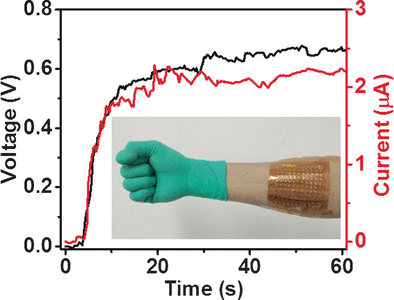Electronic components integrated into fabrics are gaining increasing popularity: systems such as smartphone displays inside the sleeve or detectors for monitoring physiological body parameters embedded in sports uniforms have already been developed and manufactured. The main problem with such systems is the lack of a wearable and convenient power source.

[Translation by Dr. Nachmani Moshe]
Electronic components integrated into fabrics are gaining increasing popularity: systems such as smartphone displays inside the sleeve or detectors for monitoring physiological body parameters embedded in sports uniforms have already been developed and manufactured.
Electronic components integrated into fabrics are gaining increasing popularity: systems such as smartphone displays inside the sleeve or detectors for monitoring physiological body parameters embedded in sports uniforms have already been developed and manufactured. The main problem with such systems is the lack of a wearable and convenient power source. Scientists from China are now trying to obtain the energy required to operate these systems while utilizing body heat. In an article describing their findings and published in the scientific journal Angewandte Chemie, the scientists explain how they succeeded in developing a flexible and wearable heating cell based on two different electrolytes in gel form.
Muscle activity and also our metabolism cause the body to produce constant heat, part of which is emitted through the skin into the external environment. Due to the relatively small gap between the skin temperature (about 32 degrees Celsius) and the ambient temperature, it is not easy to take advantage of the emitted body heat. Previous heat production systems, for example those based on semiconductor materials, release too little energy, and in addition - they are expensive and unsuitable for integration into wearable devices. Heat production systems based on solutions of electrolytes are challenging in terms of integrating them into existing wearable devices. Scientists from China have found the solution to this problem: using heat-generating systems based on electrolytes in gel form.
The researchers take advantage of the use of a thermogalvanic result: if two electrodes that are in contact with an electrolytic solution - or an electrolytic gel - are kept at different temperatures, a potential gap is formed between them. The ions that make up the redox pair (the forms that participate in the oxidation-reduction reaction) in the electrolyte can quickly jump between two different charge states, that is - accept or release electrons into the electrodes at the different temperatures. In order to take advantage of this phenomenon to generate an electric current, the researchers combined two types of cells that include two different redox pairs. Each of the cells consists of tiny metal plates that function as the electrodes, with the gel electrolyte in between. The first cell type contains the redox couple Fe2+/Fe3+, while the second type contains the couple [Fe(CN)6]3-/[Fe(CN)6]4-. In this configuration one end produces a negative potential, while the other end produces a positive potential. The cells themselves were connected to each other in a serial array. In the next step, the researchers integrated the entire array into a glove. When the glove is heated, the required temperature difference between the upper plate and the lower plate is obtained. This array produces an electrical voltage between neighboring cells, and thus the voltage accumulates. The system is able to generate an electric current that will be sufficient to operate an electrical device or to charge a battery. In an environment of 5 degrees Celsius the system achieved a voltage of 0.7 volts. Optimizing the system may allow an improvement in the voltage level obtained, even with lower temperature differences.

3 תגובות
No.)
There is nothing to compare to solar collectors, because they are currently not really wearable. The consumption of a wearable garment should not be either
High.
I think it is already significant to incorporate it into clothing for snow, both for lighting and for locating emergency situations.
In short, there is nothing to talk about Israel here in the summer, sometimes the temperature even exceeds 38.
In any case, sounds like a nice theoretical study and nothing more. It is clear that the problem that the research is trying to solve is temporary and will be solved with the development of batteries. In any case, it doesn't seem to have even a theoretical chance of surpassing the efficiency of the simplest solar collectors. If anything it sounds interesting for producing electricity at low voltages from weak heat sources.
Thermoelectric components can be used to generate electric voltage by the temperature difference between the sides, (Sibek effect).
Assuming that the skin temperature in a certain area is 32 degrees Celsius and the ambient temperature is 12 degrees.
At a difference of 20 degrees it is possible to produce a voltage of 0.97V with a current of 225mA.
(As the temperature difference increases, so do the voltage and current.)
This method can only be used in cold areas where it is possible to create a temperature difference between the body and the environment.